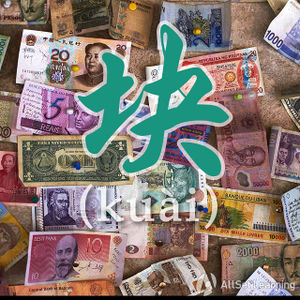Difference between revisions of "Counting money"
| Line 3: | Line 3: | ||
Cash is king, and China is no exception. Mastering how to say quantities of money is vital! | Cash is king, and China is no exception. Mastering how to say quantities of money is vital! | ||
| − | == Structure == | + | == Saying Quantities of Money == |
| + | |||
| + | === Structure === | ||
Chinese has a specific structure for talking about quantities for money: | Chinese has a specific structure for talking about quantities for money: | ||
| Line 13: | Line 15: | ||
</div> | </div> | ||
| − | == Examples == | + | === Examples === |
<div class="liju"> | <div class="liju"> | ||
| + | * 两 <em>块</em> 五 <em>毛</em> <span class="pinyin">liǎng <em>kuài</em> wǔ <em>máo</em></span><span class="trans">two kuai five mao (2.5)</span> | ||
* 三 <em>块</em> 八 <em>毛</em> <span class="pinyin">sān <em>kuài</em> bā <em>máo</em></span><span class="trans">three kuai eight mao (3.8)</span> | * 三 <em>块</em> 八 <em>毛</em> <span class="pinyin">sān <em>kuài</em> bā <em>máo</em></span><span class="trans">three kuai eight mao (3.8)</span> | ||
* 十 <em>块</em> 两 <em>毛</em> <span class="pinyin">shí <em>kuài</em> liǎng <em>máo</em></span><span class="trans">ten kuai two mao (10.2)</span> | * 十 <em>块</em> 两 <em>毛</em> <span class="pinyin">shí <em>kuài</em> liǎng <em>máo</em></span><span class="trans">ten kuai two mao (10.2)</span> | ||
| − | * | + | * 二十 三 <em>块</em> 八<span class="pinyin">èrshí-sān <em>kuài</em> bā</span><span class="trans">Twenty-three kuai eight mao (23.8)</span> |
| − | |||
* 五 十 <em>块</em> 五 <em>毛</em> <span class="pinyin">wǔshí <em>kuài</em> wǔ <em>máo</em></span><span class="trans">fifty kuai five mao (50.5)</span> | * 五 十 <em>块</em> 五 <em>毛</em> <span class="pinyin">wǔshí <em>kuài</em> wǔ <em>máo</em></span><span class="trans">fifty kuai five mao (50.5)</span> | ||
</div> | </div> | ||
| + | |||
| + | Note that ''2.5 RMB'' reads as "两 <em>块</em> 五 (liǎng kuài wǔ)", not "二 <em>块</em> 五 (èr kuài wǔ)". | ||
If the smaller units are only in tens, you can just say the number of tens. So ''3.8 RMB'' is "三 <em>块</em> 八 (sān kuài bā)." Also this way of speaking is normally only used in matters with less than 100. | If the smaller units are only in tens, you can just say the number of tens. So ''3.8 RMB'' is "三 <em>块</em> 八 (sān kuài bā)." Also this way of speaking is normally only used in matters with less than 100. | ||
| + | |||
| + | When the smaller unit is two, you might need to pay a little attention to this: | ||
| + | |||
<div class="liju"> | <div class="liju"> | ||
| − | * | + | * 两 <em>块</em> 二 <span class="pinyin">liǎng <em>kuài</em> èr</span><span class="trans">two kuai two mao (2.2)</span> |
| − | * | + | * 五 <em>块</em> 二 <span class="pinyin">wǔ <em>kuài</em> èr</span><span class="trans">five kuai two mao (5.2)</span> |
| − | |||
| − | |||
| − | |||
</div> | </div> | ||
Revision as of 03:08, 4 February 2017
-
Level
-
Similar to
-
Used for
-
Keywords
Cash is king, and China is no exception. Mastering how to say quantities of money is vital!
Contents
Saying Quantities of Money
Structure
Chinese has a specific structure for talking about quantities for money:
Number + 块 + Number + 毛
Examples
- 两 块 五 毛 two kuai five mao (2.5)
- 三 块 八 毛 three kuai eight mao (3.8)
- 十 块 两 毛 ten kuai two mao (10.2)
- 二十 三 块 八Twenty-three kuai eight mao (23.8)
- 五 十 块 五 毛 fifty kuai five mao (50.5)
Note that 2.5 RMB reads as "两 块 五 (liǎng kuài wǔ)", not "二 块 五 (èr kuài wǔ)".
If the smaller units are only in tens, you can just say the number of tens. So 3.8 RMB is "三 块 八 (sān kuài bā)." Also this way of speaking is normally only used in matters with less than 100.
When the smaller unit is two, you might need to pay a little attention to this:
- 两 块 二 two kuai two mao (2.2)
- 五 块 二 five kuai two mao (5.2)
The first number is the amount of whole RMB (or dollars etc.), and the second is the amount smaller units (e.g. cents). So 3.86 RMB is
- 三 块 八 毛 六three kuai eight mao six fen (3.86)
And if there's no smaller unit, e.g. 3 RMB, you can just say:
- 三 块 Three kuai
块 (kuài) is the more common, informal way to talk about money. More formally you can use 元 (yuán) in exactly the same way. This is similar to the difference between "dollars" and "bucks" in American English, or "pounds" and "quid" in British English. 块 (kuài) is appropriate in more situations than "bucks" or "quid", though.
See also
Sources and further reading
Books
- A Practical Chinese Grammar For Foreigners (外国人实用汉语语法) (pp. 88-9) →buy
- Integrated Chinese: Level 1, Part 1 (3rd ed) (pp. 233-4) →buy



